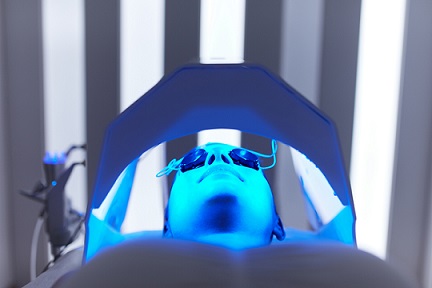
It seems like every Dermatologist is recommending photodynamic therapy (PDT) for the treatment of actinic keratosis to their patients these days. Why the sudden explosion with this treatment? Is it really that good? Is it really the best? Is it really what we should be recommending to our patients?
The simple answer is yes and no.
History of Photodynamic Therapy
Photodynamic therapy has been around since the early 2000’s for the treatment of actinic keratosis and shortly after that, for the treatment of superficial basal cell carcinoma.
Despite this treatment being available for decades, why has it only became popular in the 2020’s?
Is it better now than before? Yes, it is better for both patient AND physician. The original method of PDT required patients to come into the office at the end of a day for the medicine to be applied to the skin. They returned the next day for the blue light treatment. Obviously, this is inconvenient for the patient as the treatment takes two days. This is disadvantage number one. More importantly, the treatment was very uncomfortable. Moderate to severe burning and stinging occurred during the treatment session on day 2. This is disadvantage number two. But wait, disadvantage three is coming up so be patient.
How has photodynamic therapy changed?
In the recent years, a newer regimen in which patients have the medicine applied and then have the blue light treatment one hour later. This is much more convenient and much less uncomfortable then before. The treatment does very well, although many patients experience redness, swelling, and a burning sensation during the light treatment and many will have some skin irritation afterwards than can be mild or moderate.
Are so many Dermatologists offering this treatment because it is fairly well tolerated and works well?
One would hope so, as it is a good treatment. But, it is not the most effective treatment. Therefore, if your Dermatologist is recommending this treatment, he or she is not necessarily recommending the most effective treatment. This is disadvantage number three. Also, this is an expensive treatment, which pays the Dermatologist very well and, in most cases, that is why it is recommended so frequently. This is disadvantage number four.
Should I get PDT?
In short, PDT is a good treatment option for the treatment of actinic keratosis. It works well, but one must spend about 90 minutes in the Dermatologist’s office. The nice thing is that patients do not have to do anything at home–no creams or topical products to buy or use. It’s simple. But, this comes with a higher price tag than some other treatments and one must look at the costs involved as well. For example, imiquimod can be purchased for as little as $18, even when one has no health insurance, using savings plans like www.goodrx.com, which are free to use. Other treatments using 5-fluoruracil and calcipotriene can be compounded for as little as $30 if you shop around and only required 5-6 days of application with minimal irritation. This latter regimen has been proven to be the most effective, is fairly well tolerated, and should be considered a primary treatment for actinic keratosis.
In summary, PDT is a good option for the treatment of actinic keratosis. It is best for patients who cannot or do not want to apply creams or those who are not compliant. This treatment generally costs more than several other treatment options, which should be taken into account when choosing this option.
Dr. Bader’s recommendations about actinic keratosis treatment
Always ask about other treatment options, as PDT is not the only option and therefore should not be the only option discussed or offered. Topical 5-fluorouracil and calcipotriene is superior in terms of initial clearing and long term clearing in healthy patients. A compound pharmacy can mix this for around $30 so do not overpay for this product. This regimen should not be confused with 5-fluorouracil which is used alone, which has a lower cure rate and is far more irritating. Imiquimod is another good alternative, but treatment takes a little longer and is more irritating.
